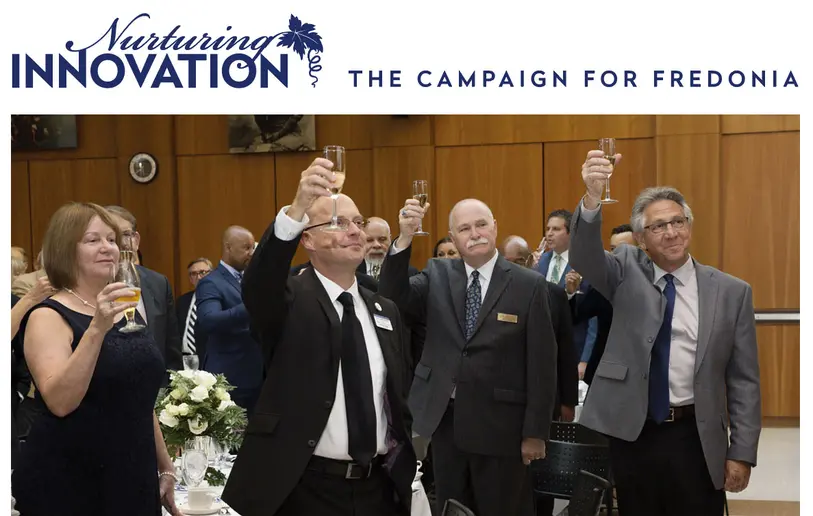The kickoff of the public phase of the campaign, titled “Nurturing Innovation: The Campaign for Fredonia,” took place in front of hundreds of guests during the annual Homecoming Excellence Gala Dinner Oct. 20, 2017 in the Williams Center on the Fredonia campus.
The kickoff of the public phase of the campaign, titled “Nurturing Innovation: The Campaign for Fredonia,” took place in front of hundreds of guests during the annual Homecoming Excellence Gala Dinner Oct. 20 in the Williams Center.
The goal of the campaign is to raise $20 million over the next three years. Fredonia has raised more than $14 million in gifts and pledges as part of the campaign’s “silent phase,” which began in 2014.
“We are reimagining the key attributes of a quality education, by offering internships, student research, study abroad, and volunteer opportunities; all of which are as valuable as time spent in the classroom,” said Fredonia President Virginia Horvath.
The campaign, conducted through the Fredonia College Foundation, will focus on five key areas: providing scholarships to students who are high-achieving, but in need of assistance to make college affordable; supporting faculty-student research collaborations, internships, and entrepreneurial activities; enhancing faculty research and creative activity; redesigning and reimagining existing classrooms and other spaces; and providing flexibility to direct funds to areas of strategic importance and greatest need.
“More than ever, students and families are looking for a place like Fredonia, and this campaign will define the ways this university builds on that tradition,” said Interim Vice President for University Advancement Betty (Catania) Gossett, ’76. “We will use this campaign to nurture critical thinking, and support innovative approaches. We are committed to working together to challenge students and support their development to become skilled, creative, connected and responsible graduates.”
Fredonia College Foundation board members Dennis Costello, Class of ’72, and Joseph Falcone, Class of ’74, are co-chairs of the campaign.
“Our generous donors have laid the foundation for this capital campaign,” said Costello. “The success of the ‘Nurturing Innovation’ campaign will move Fredonia forward by enhancing its academic scope and scale for the next generation and beyond, by supporting our faculty, and by strengthening our endowment.”
“The value of a Fredonia education is as clear as it has ever been,” said Falcone. “We are all committed to working together to create the best environment for student success. This capital campaign will help Fredonia take those vital next steps to expand opportunities in and out of the classroom.”
Today’s Fredonia is very different from the one which existed 50, or even 20, years ago. It has undergone transformational change to the benefit of students and Western New York. Fredonia is much larger than most alumni remember—or than most current community members realize. There are far more students and they’re far more diverse. Fredonia graduates nearly 1,400 students annually. Fredonia’s presence in the community is equally impressive, with over 1,000 employees and a $330 million annual economic impact statewide—most of which is spent in the region. Its direct, indirect and induced economic activity provide a lifeblood of commerce for numerous retailers, construction firms, hospitality and tourism entrepreneurs, and other service providers. In addition, over 32,000 of Fredonia’s nearly 43,000 alumni still call the state home, and more than 500 of the nearly 600 internships completed by Fredonia students each year occur in Western New York.
Fredonia is nearing its 200th year of graduating successful alumni. Although its leaders are doing their part to control expenses, state funding now comprises less than 12 percent of the campus’ consolidated operating budget. With such substantial declines in state support throughout the decades, the majority of operational expenditures are now funded through tuition instead of state funds, leaving the university to fill the gap. Annual tuition in the 1960s was $400 compared to $6,470 today. Furthermore, 37 percent of today’s students are eligible for federal Pell Grants, meaning that their family annual household income is less than $40,000. To fully deliver on its mission and promise to students, Fredonia needs the foresight and generosity of its alumni and friends.
Fredonia has launched a new website at www.fredonia.edu/nurture that highlights stories related to the campaign, from successful alumni, to current scholarship winners, to programs funded by benefactors.





